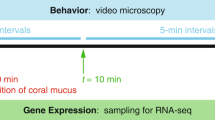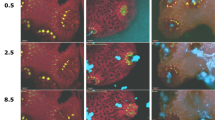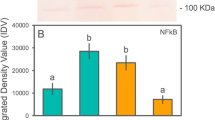Abstract
Evidence to date indicates that elevated seawater temperatures increase the occurrence of coral disease, which is frequently microbial in origin. Microbial behaviors such as motility and chemotaxis are often implicated in coral colonization and infection, yet little is known about the effect of warming temperatures on these behaviors. Here we present data demonstrating that increasing water temperatures induce two behavioral switches in the coral pathogen Vibrio coralliilyticus that considerably augment the bacterium’s performance in tracking the chemical signals of its coral host, Pocillopora damicornis. Coupling field-based heat-stress manipulations with laboratory-based observations in microfluidic devices, we recorded the swimming behavior of thousands of individual pathogen cells at different temperatures, associated with current and future climate scenarios. When temperature reached ⩾23 °C, we found that the pathogen’s chemotactic ability toward coral mucus increased by >60%, denoting an enhanced capability to track host-derived chemical cues. Raising the temperature further, to 30 °C, increased the pathogen’s chemokinetic ability by >57%, denoting an enhanced capability of cells to accelerate in favorable, mucus-rich chemical conditions. This work demonstrates that increasing temperature can have strong, multifarious effects that enhance the motile behaviors and host-seeking efficiency of a marine bacterial pathogen.
Similar content being viewed by others
Log in or create a free account to read this content
Gain free access to this article, as well as selected content from this journal and more on nature.com
or
References
Baker AC, Glynn PW, Riegl B . (2008). Climate change and coral reef bleaching: An ecological assessment of long-term impacts, recovery trends and future outlook. Estuar Coast Shelf Science 80: 435–471.
Banin E, Israely T, Fine M, Loya Y, Rosenberg E . (2001). Role of endosymbiotic zooxanthellae and coral mucus in the adhesion of the coral-bleaching pathogen Vibrio shiloi to its host. Fems Microbiol Lett 199: 33–37.
Bell W, Mitchell R . (1972). Chemotactic and growth responses of marine bacteria to algal extracellular products. Biol Bull 143: 265.
Ben-Haim Y, Rosenberg E . (2002). A novel Vibrio sp pathogen of the coral Pocillopora damicornis. Marine Biol 141: 47–55.
Ben-Haim Y, Zicherman-Keren M, Rosenberg E . (2003). Temperature-regulated bleaching and lysis of the coral Pocillopora damicornis by the novel pathogen Vibrio coralliilyticus. Appl Environ Microbiol 69: 4236–4242.
Blackburn N, Fenchel T, Mitchell J . (1998). Microscale nutrient patches in planktonic habitats shown by chemotactic bacteria. Science 282: 2254–2256.
Burge CA, Eakin CM, Friedman CS, Froelich B, Hershberger PK, Hofmann EE et al. (2014). Climate change influences on marine infectious diseases: Implications for management and society. Annu Rev Marine Sci 6: 249–277.
Case RJ, Longford SR, Campbell AH, Low A, Tujula N, Steinberg PD et al. (2011). Temperature induced bacterial virulence and bleaching disease in a chemically defended marine macroalga. Environ Microbiol 13: 529–537.
Garren M, Azam F . (2012). Corals shed bacteria as a potential mechanism of resilience to organic matter enrichment. ISME J 6: 1159–1165.
Garren M, Son K, Raina JB, Rusconi R, Menolascina F, Shapiro OH et al. (2014). A bacterial pathogen uses dimethylsulfoniopropionate as a cue to target heat-stressed corals. ISME J 8: 999–1007.
Heron SF, Willis BL, Skirving WJ, Eakin CM, Page CA, Miller IR . (2010). Summer hot snaps and winter conditions: Modelling White Syndrome outbreaks on Great Barrier Reef corals. Plos One 5: e12210.
Hoegh-Guldberg O . (2004). Coral reefs in a century of rapid environmental change. Symbiosis 37: 1–31.
Kimes NE, Grim CJ, Johnson WR, Hasan NA, Tall BD, Kothary MH et al. (2012). Temperature regulation of virulence factors in the pathogen Vibrio coralliilyticus. ISME J 6: 835–846.
Larsen MH, Blackburn N, Larsen JL, Olsen JE . (2004). Influences of temperature, salinity and starvation on the motility and chemotactic response of Vibrio anguillarum. Microbiology 150: 1283–1290.
Maeda K, Imae Y, Shioi JI, Oosawa F . (1976). Effect of temperature on motility and chemotaxis of Escherichia coli. J Bacteriol 127: 1039–1046.
Magariyama Y, Sugiyama S, Muramoto K, Kawagishi I, Imae Y, Kudo S . (1995). Simultaneous measurement of bacterial flagellar rotation rate and swimming speed. Biophys J 69: 2154–2162.
Mandel MJ, Schaefer AL, Brennan CA, Heath-Heckman EAC, DeLoney-Marino CR, McFall-Ngai MJ et al. (2012). Squid-derived chitin oligosaccharides are a chemotactic signal during colonization by Vibrio fischeri. Appl Environ Microbiol 78: 4620–4626.
Maynard J, van Hooidonk R, Eakin CM, Puotinen M, Heron SF, Garren M et al. (2015). Climate projections of conditions that increase coral disease susceptibility and pathogen virulence. Nat Clim Change doi: 10.1038/nclimate2625.
Meron D, Efrony R, Johnson WR, Schaefer AL, Morris PJ, Rosenberg E et al. (2009). Role of flagella in virulence of the coral pathogen Vibrio coralliilyticus. Appl Environ Microbiol 75: 5704–5707.
Otoole R, Milton DL, Wolf WH . (1996). Chemotactic motility is required for invasion of the host by the fish pathogen Vibrio anguillarum. Mol Microbiol 19: 625–637.
Pandolfi JM, Bradbury RH, Sala E, Hughes TP, Bjorndal KA, Cooke RG et al. (2003). Global trajectories of the long-term decline of coral reef ecosystems. Science 301: 955–958.
Pollock FJ, Wilson B, Johnson WR, Morris PJ, Willis BL, Bourne DG . (2010). Phylogeny of the coral pathogen Vibrio coralliilyticus. Environ Microbiol Rep 2: 172–178.
Rosenberg E, Falkovitz L . (2004). The Vibrio shiloi/Oculina patagonica model system of coral bleaching. Annu Rev Microbiol 58: 143–159.
Ruiz-Morenol D, Willis BL, Page AC, Weil E, Croquer A, Vargas-Angel B et al. (2012). Global coral disease prevalence associated with sea temperature anomalies and local factors. Dis Aquat Organ 100: 249–261.
Seymour JR, Ahmed T, Marcos, Stocker R . (2008). A microfluidic chemotaxis assay to study microbial behavior in diffusing nutrient patches. Limnol Oceanogr Methods 6: 477–488.
Seymour JR, Simó R, Ahmed T, Stocker R . (2010). Chemoattraction to Dimethylsulfoniopropionate throughout the marine microbial food web. Science 329: 342–345.
Stocker R, Seymour JR . (2012). Ecology and physics of bacterial chemotaxis in the ocean. Microbiol Mol Biol Rev 76: 792–812.
Son K, Brumley DR, Stocker R . (2015). Live from under the lens: exploring microbial motility with dynamic imaging and microfluidics. Nat Rev Microbiol 13: 761–775.
Taylor JR, Stocker R . (2012). Trade-offs of chemotactic foraging in turbulent water. Science 338: 675–679.
Toren A, Landau L, Kushmaro A, Loya Y, Rosenberg E . (1998). Effect of temperature on adhesion of Vibrio strain AK-1 to Oculina patagonica and on coral bleaching. Appl Environ Microbiol 64: 1379–1384.
Tout J, Jeffries TC, Petrou K, Tyson GW, Webster NS, Garren M et al. (2015a). Chemotaxis by natural populations of coral reef bacteria. ISME J 9: 1764–1777.
Tout J, Siboni N, Messer LF, Garren M, Stocker R, Webster NS et al. (2015b). Increased seawater temperature increases the abundance and alters the structure of natural Vibrio populations associated with the coral Pocillopora damicornis. Front Microbiol 6: 432.
Weibel DB, DiLuzio WR, Whitesides GM . (2007). Microfabrication meets microbiology. Nat Rev Microbiol 5: 209–218.
Weil E, Croquer A, Urreiztieta I . (2009). Temporal variability and impact of coral diseases and bleaching in La Parguera, Puerto Rico from 2003–2007. Caribbean J Sci 45: 221–246.
Acknowledgements
We thank DG Bourne, JB Raina, PJ Ralph, V Fernandez, J Guasto, J Lindholm, T Santiano-McHatton, R Schilling and the staff at the Heron Island Research Station. This work was supported by the Human Frontiers in Science Program award no. RGY0089 to RS and JRS, by a Gordon and Betty Moore Foundation Investigator Grant (GBMF3783) to RS, by Australian Research Council Grants DP110103091 and FT130100218 to JRS, and by NSF awards CBET-1066566 and CBET-0966000 to RS. We are grateful to the Great Barrier Reef Marine Park Authority for coral collection permits G09/31733.1 (PJ Ralph, University of Technology Sydney) and G12/35236.1 (Australian Institute of Marine Science).
Author information
Authors and Affiliations
Corresponding authors
Ethics declarations
Competing interests
The authors declare no conflict of interest.
Additional information
Supplementary Information accompanies this paper on The ISME Journal website
Rights and permissions
About this article
Cite this article
Garren, M., Son, K., Tout, J. et al. Temperature-induced behavioral switches in a bacterial coral pathogen. ISME J 10, 1363–1372 (2016). https://doi.org/10.1038/ismej.2015.216
Received:
Revised:
Accepted:
Published:
Issue date:
DOI: https://doi.org/10.1038/ismej.2015.216
This article is cited by
-
Microbiota of healthy and bleached corals of the species Siderastrea stellata in response to river influx and seasonality in Brazilian northeast
Environmental Science and Pollution Research (2022)
-
Microscale tracking of coral-vibrio interactions
ISME Communications (2021)
-
Coral mucus rapidly induces chemokinesis and genome-wide transcriptional shifts toward early pathogenesis in a bacterial coral pathogen
The ISME Journal (2021)
-
Antagonism between coral pathogen Vibrio coralliilyticus and other bacteria in the gastric cavity of scleractinian coral Galaxea fascicularis
Science China Earth Sciences (2020)
-
Rapid environmental change shapes pond water microbial community structure and function, affecting mud crab (Scylla paramamosain) survivability
Applied Microbiology and Biotechnology (2020)



